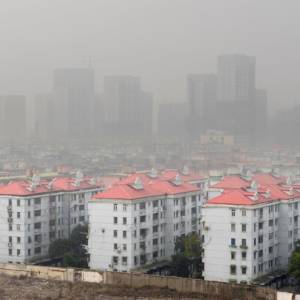Up to 30% of new and remodeled buildings worldwide may be the subject of excessive complaints related to indoor air quality (IAQ) according to the World Health Organization. The term Sick Building Syndrome (SBS) describes situations in which people experience health and comfort effects that appear to be linked to time spent within a building, but for which no specific illness or cause can be identified. Building Related Illness (BRI) is used to describe symptoms of diagnosable illness that is directly attributed to airborne building contaminants.

While BRI can be temporary, some buildings have long-term problems resulting from deficient (or non-existent) operational and maintenance procedures, building design, or even occupant activities.
Causes can include the following:
1. Inadequate ventilation via the heating, ventilation, and air conditioning systems (HVAC) which do not effectively distribute air to people in the building
2. Chemical contaminants from indoor sources such as building materials themselves, including but not limited to the following: asbestos, adhesives, carpeting, cleaning agents that may contain volatile organic compounds, or other respirable particulate matter
3. Chemical contaminants from outdoor sources such as motor vehicle exhausts, plumbing vents and building exhausts which can “intake” such contaminants from the building exterior via windows, vents, and other building openings
4. Biological contaminants such as bacteria, molds, pollen, and viruses accumulating in ducts, humidifiers, and drain pans
Symptoms of BRI include cough, chest tightness, fever, chills, and muscle aches with the potential for prolonged recovery times after leaving the building with existing conditions (i.e. – allergies, asthma) exacerbated by IAQ conditions of the building.
Discussions on exposures and risks regarding Building Related Illness can be alleged as pollution conditions. Such claims include bodily injury, property damage, remediation (clean-up costs) and legal expense and defense costs. Examples include the following:
- Bodily Injury and Business Interruption: $65,000
A medical clinic was a tenant in a commercial office building. A release of gas occurred from the medial clinic that required evacuation of the building and caused lung damage to several third-parties. Other tenants were unable to return to the building for several days while the situation was investigated and the site was approved for occupancy. The building owner paid $65,000 in claims for business interruption and bodily injury to third-parties. - Mold Remediation, Bodily Injury, and Defense Costs: $150,000
The tenants of an office building complained of illness. After testing the indoor air, it was determined that the illness was caused by mold that was circulated around the building in the air conditioning system. The building owner paid for mold remediation cost, bodily injury, and defense costs. - Mold Remediation and Business Interruption: $225,000
A commercial office building owner was performing construction for new tenants when mold was discovered behind wall coverings. The mold growth had resulted from moisture due to the air conditioning system not being run while the tenant space was unoccupied. Through investigation and remediation of the mold space, it was learned that adjacent tenant spaces had been complaining of illnesses prior to the mold discovery. Building leases had to either be postponed or rental payments had to be reduced due to the IAQ concerns of the building resulting in business interruption expenses.
Building-Related Illness and Insurance Exposures
Pollution insurance is a risk management tool utilized by property owners to mitigate their exposure to IAQ. Claims and loss can arise from a variety of sources as noted above via the following liability routes (all with associated legal expense and defenses for investigation of allegations to prove negligence or fault on behalf of the accused party):
- Remediation (Cleanup Costs): IAQ contaminants can easily spread to entire buildings through heating, ventilation, and air conditioning systems and are often “hiding” behind dry wall or above ceilings due to long-term leaks or exposure to water that have gone unnoticed. Many remediation efforts require professional service providers that meet governmental guidelines for certification (i.e. – Certified Industrial Hygienists) to ensure proper and complete remediation, which can be costly.
- Bodily Injury: Indoor air contaminant exposures can cause or exacerbate allegoric reactions, asthma, or other respiratory complaints, including irritation of eyes, skin, nose, throat, and lungs manifesting as hay fever-like symptoms such as sneezing, runny nose, red eyes, and skin rashes.
- Property Damage: Mold may settle onto a variety of building materials and content and will gradually destroy the things that they grow upon. Once mold has affected the item such as furnishing or drywall, often the only remedy is to completely remove the mold-contaminated surfaces which can result in significant costs for replacement of such property that was damaged.
In each of the above exposures, pollution insurance, in conjunction with other risk management protocols and procedures for inhibiting IAQ concerns, can assist owners and operators of properties in managing their liabilities associated with indoor air quality.
Additional Prevention Measures
Controlling moisture is the best way to control potential building related illness. The following prevention measures are often helpful in inhibiting exposures:
- Have a communication strategy to notify appropriate parties immediately if there is suspicion of an indoor quality problem
- Ensure all furniture or building supplies are not blocking air vents or grilles
- Implement a preventative indoor air quality management program following guidance issued by the Environmental Protection Agency and the National Institute for Occupational Safety and Health.
Resources and Additional Information
For additional resources and information, please visit the following websites:
Center for Disease Control (CDC): www.cdc.gov/niosh/homepage.html
American Society of Heating, Refrigerating and Air-Conditioning Engineers (ASHRAE): www.ashrae.org
Environmental Protection Agency (EPA): www.epa.gov/indoor-air-quality-iaq/
Written by Jamie Langes, Assistant Vice President, Tokio Marine Specialty Insurance Company (TMSIC)

